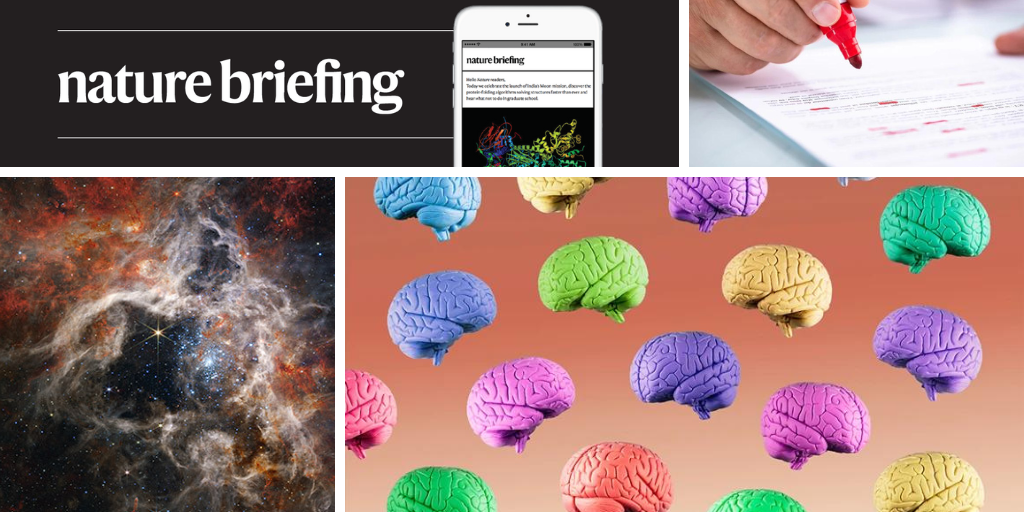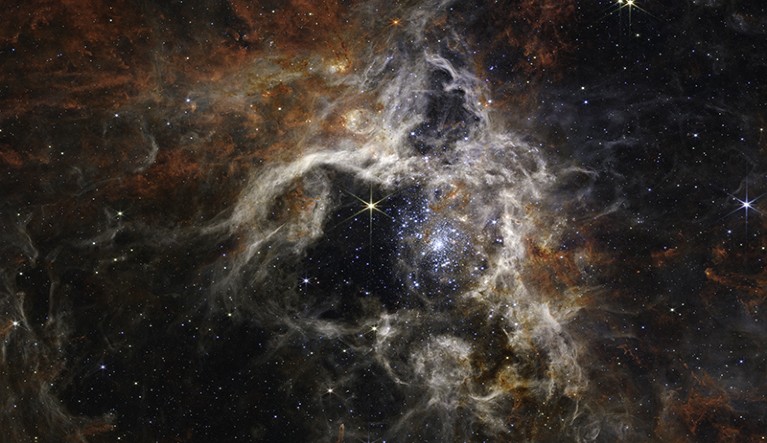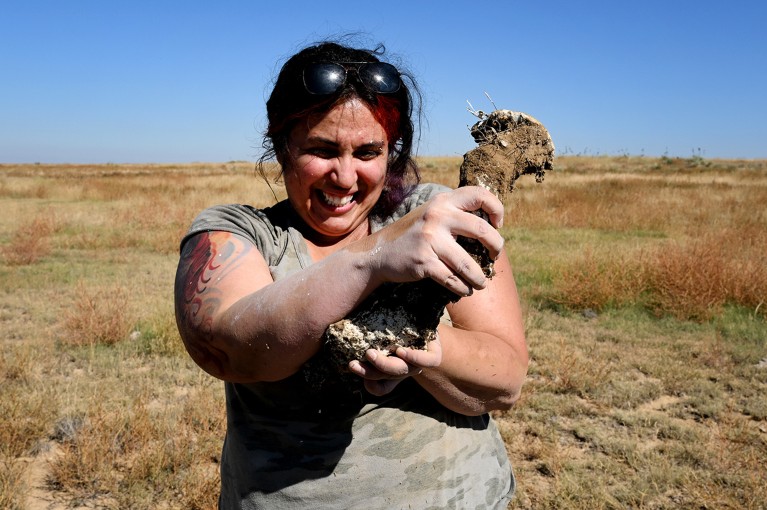Hello Nature readers, would you like to get this Briefing in your inbox free every day? Sign up here
Credit: NASA, ESA, CSA, STScI, Webb ERO Production Team
The spider’s web of the Tarantula Nebula sparkles with thousands of newborn stars in one of the many stunning images captured in unprecedented detail by the infrared instruments on the James Webb Space Telescope (JWST). Powerful stellar winds coming from massive blue stars have hollowed out the nebula’s centre, and an older star radiates bright yellow spikes, which are an observational artefact.See more of the JWST’s sharpest shots so far, selected by Nature’s photo team.
After 30 years of planning, building work on the world’s largest radio telescope has finally kicked off at remote sites in South Africa and Australia. The ultimate goal is to have thousands of antennas covering a total collecting area of one square kilometre — thus its name, the Square Kilometre Array (SKA). The large distances between antennas, and their sheer number, mean that the SKA will pick up radio signals with unprecedented sensitivity.
Publishers are trialling tools to detect research coming from paper mills — businesses that churn out bogus research papers. Publishers and scholarly analytics providers have collaborated on three fronts:
• A tool that scans for 70 signs of a fake paper (the specific signs remain a secret)
• An analysis of available software to spot manipulated images
• A tool that signals whether a manuscript has been submitted to several journals at once, which paper mills do to get work published more quickly.
Features & opinion
Some neurodivergent researchers can be made to feel excluded and undervalued in the scientific workplace. “This is particularly the case in academia, where we are expected to be intellectually excellent — and to work in an environment that is incredibly competitive and that demands hyperproductivity as a matter of course,” says Jennifer Leigh, who studies higher education and academic practice and has attention deficit hyperactive disorder (ADHD). “There is little support available — and, for many, the risks of disclosure tend to outweigh the benefits.” Four neurodivergent researchers — one with cerebral palsy, two with ADHD and one who is autistic — share their experiences and suggest changes to the structure of science.
Around the time of the American War of Independence, the region was plagued by smallpox outbreaks. Inoculation with live virus could save lives but could also trigger epidemics. The communal risk and cooperation required to successfully leverage the procedure helped to build “a newborn nation, united in part by its commitment to public health”, argues historian Andrew Wehrman in his new book. Ironically, a safer, cowpox-based vaccine saw that unity crumble. “Suddenly, administration of the vaccine did not pose communal risk; therefore, its distribution did not inspire communal action,” writes reviewer and Nature reporter Heidi Ledford. “It is a tale of startling contemporary relevance,” she notes.
The proton might feel like a familiar friend, but it “is the most complicated thing that you could possibly imagine”, says physicist Mike Williams. “In fact, you can’t even imagine how complicated it is.” Quanta offers a beautifully illustrated survey of the particle’s wonders, focusing on its paradoxical building blocks — quarks.
Where I work
Based in Westminster, Colorado, Jackie Billotte is a PhD candidate in agricultural biology at Colorado State University in Fort Collins.Credit: Helen H. Richardson/MediaNews Group/The Denver Post via Getty
Entomologist Jackie Billotte reconstructs the burrows and housekeeping habits of tarantulas. The arachnids help to keep insect and rodent populations under control in southeastern Colorado. “We lure the tarantulas out of their burrow using a piece of grass, and then we collect them with a one-litre plastic cup,” she says. “We pour quick-set plaster of Paris into the burrow. Once it’s dry, we dig out the cast. The first one, that I’m holding here, turned out to be 60 centimetres deep. This does destroy the burrow, but we dig the tarantula a new starter burrow nearby.” (Nature | 3 min read) (Helen H. Richardson/MediaNews Group/The Denver Post via Getty)









More News
Judge dismisses superconductivity physicist’s lawsuit against university
Future of Humanity Institute shuts: what’s next for ‘deep future’ research?
Star Formation Shut Down by Multiphase Gas Outflow in a Galaxy at a Redshift of 2.45 – Nature